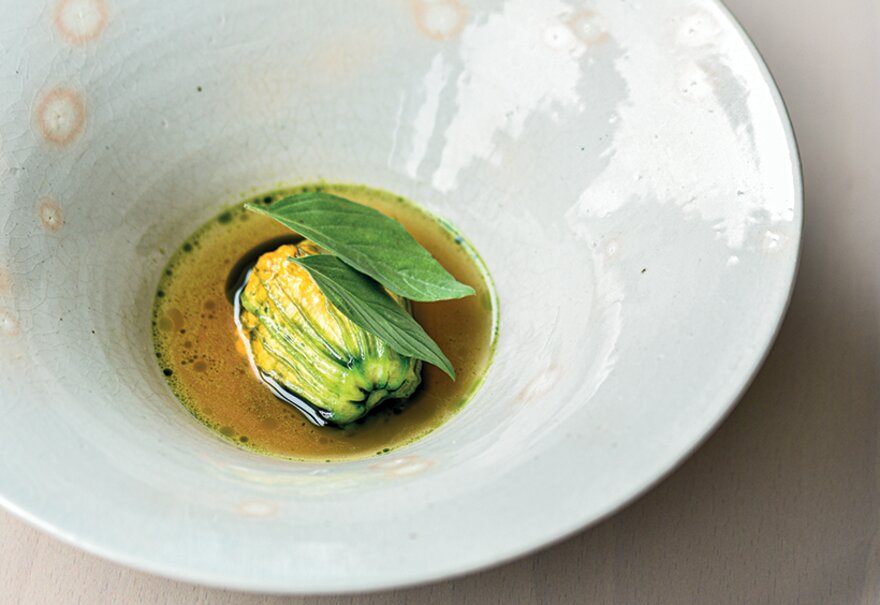A pinch of Korea, a dash of France and a glug of London – Sollip's menu is based on its chefs' own life experiences. Maria Mellor takes a seat at a Michelin-starred table
Sollip's menu is like looking at Woongchul Park and Bomee Ki's collection of souvenirs from their travels across the globe. But instead of snowglobes and novelty shot glasses, the husband and wife duo's experiences are reflected in ingredients, cooking techniques and flavour combinations.
"Food shows your experience, not just as a chef but as a person," says Park, a fact he upholds with each dish. But don't be tempted to call this a Korean restaurant, despite its South Korean owners and Korean name (meaning "pine needle"). It's natural that Park and Ki grew up with the flavours of traditional Korean cooking and so each course is flecked with elements from home – but their cooking is grounded in their education at Le Cordon Bleu (where they first met) and combined experiences across the globe. Classic French techniques and British ingredients are as much a part of the menu as any, creating a unique dining experience.
"In our backgrounds as chefs, 90% is French technique, but at the same time we are Korean so we want to show our Korean ingredients here," says Park.
Park says the pair have travelled the globe, living in the UK, the US and Korea, before finally landing back in London to open the restaurant of their dreams. "We knew what we wanted. We have passion and ambitions as well," adds Park.
Ki is Sollip's pastry chef, while Park acts as head chef – it's a dance they've perfected as a way to both look after the restaurant and their two children. They work collaboratively on the menu, asking each other "should that go there?" or "would this work with that ingredient?"
Take for example the daikon tarte tatin, part of the nine-course tasting menu. Park wanted to take this classic French dessert and use a Korean vegetable to give it his own spin, landing eventually on the daikon radish.
"It's a famous Korean vegetable we eat every day," says Park. It was his wife's suggestion to slice the daikon thinly to create delicate layers.
The tart has been paired with a toasted barley and roast potato purée: "It's based on bland – but not bad bland, good bland – with oatiness and a little bit of nuttiness, rather than it being heavy or fresh," explains Park. The roasted potatoes are blended with onion, garlic, thyme and cream, and he then burns hay and adds it to the mix to add colour and character.
The gamtae sandwich is another example of Park and Ki's experiences. The snack, served at the beginning of the meal is reminiscent of a croque monsieur but with Duckett's Caerphilly cheese and wrapped in a Korean seaweed called gamtae – think nori but with a fine web of fibres rather than a thick sheet.
"You can only find it in the sea in South Korea," explains Park. "It has very similar flavour notes to truffle." He's a big fan of British cheese and found the idea a natural addition to the menu.
The squab course uses most of the bird among its different elements – a leg is brushed with yangyum marinade, usually used with chicken in Korea, which Park crafts from fermented tomato, Worcestershire sauce and gochujang. A tender breast and the squab's heart are cooked over charcoal, with the latter sliced in half and added to the rice bowl on the side and covered in an XO foam made with their housemade XO sauce.
Diners are then given a palate cleanser of blood orange and omija – a berry from which tea is made in Korea – and then it's time for Ki's desserts: a black pain perdu, consisting of a charcoal brioche, a burnt vanilla sauce, a pecan gratin, seortiae ice-cream and a black seoritae tuile.
"Pain perdu is one of the all-time favourite desserts for both of us," says Ki. "Colour and the sense of season are very important for me when I make a new dish, and I thought black was greatly suitable for winter time."
Seoritae is a Korean black bean – "we use it for sweet stuff, especially for rice cakes as well as some savoury food in Korea," adds Ki.
Park says the pair have a lot of ambition for the future of Sollip, with the aim of spreading Korean culture in a fine dining setting, rather than the street food for which it has become popular over the past few years.
"For me, my wife is one of the best pastry chefs," Park says. "I don't want to waste her talents, so I might open a bakery one day."
From the menu
Fermented rhubarb, beef tartare, gamtae sandwich
Crab, courgette flower, dubu, sesame and pine nut
Daikon tarte tatin, toasted barley, roasted potato and burnt hay
Nurunji sourdough and dashima butter
Skate, white asparagus, gat-kimchi romesco, maltaise
Squab, charcoaled breast, barbecued leg, parsley root
Blood orange and omija
Black pain perdu, burnt vanilla seoritae ice-cream, pecan
Black sesame madeleine
Yuza guimauve
Unit 1, 8 Melior Street, London SE1 3QP
Continue reading
You need to be a premium member to view this. Subscribe from just 99p per week.
Already subscribed? Log In













